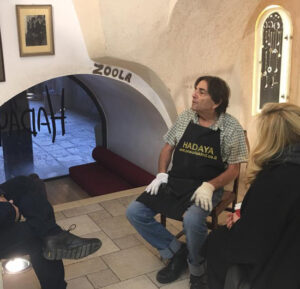I grew up in Jerusalem, where my father, Baruch Hadaya, made Hebrew words shine at his workbench, with the hum of the Jewish Quarter outside his window. At first, it was a simple silver ring engraved with the words Gam Ze Ya’avor — “This too shall pass.” It was meant for a friend going through a hard time, but it struck a chord with the stream of students, soldiers, and travelers who wandered into his shop. Before long, he was engraving biblical verses, lines from S.Y. Agnon, and phrases whispered in prayer, each one hand-lettered in Hebrew and then etched into silver and gold.
For my father, this was never only craftsmanship. It was a way of spreading the holiness of our language — letter by letter, word by word. He believed Hebrew carried a kind of spiritual charge, that the letters themselves could uplift, comfort, and connect a person to something eternal. For many visitors, their Hadaya piece wasn’t just jewelry; it became a personal amulet, a reminder of faith and resilience they could carry with them anywhere in the world.
As a child, I didn’t just watch this happen — I absorbed it. I saw how someone would walk into our shop carrying a burden and leave with something in their pocket or around their neck that made their shoulders sit higher. It taught me that being a Jew isn’t only about a synagogue ritual, it can also be about the quiet rituals we make every day — wrapping tefillin in the morning, yes, but also turning a phrase of Torah into something that rests against your heart.
Over the years, my father’s dream was for all of us — my two brothers, my mother, and me — to work together in the family shop. He didn’t live to see that dream fully realized. But in the way of other tzadikim who plant seeds they never see sprout, his vision is now our reality. We engrave the same verses he did, tell the same stories he told, and pass Hebrew into the hands of new generations, one piece of jewelry at a time.
His legacy is more than the thousands of rings, necklaces, and bracelets scattered across the world — it’s the way he taught us to carry Hebrew, to wear it, and to let it shape our Jewish lives. For me, it’s impossible to separate my own Jewish identity from this work, because it’s through this work that I learned the power of our language, our history, and our small, beautiful way to keep both alive.


